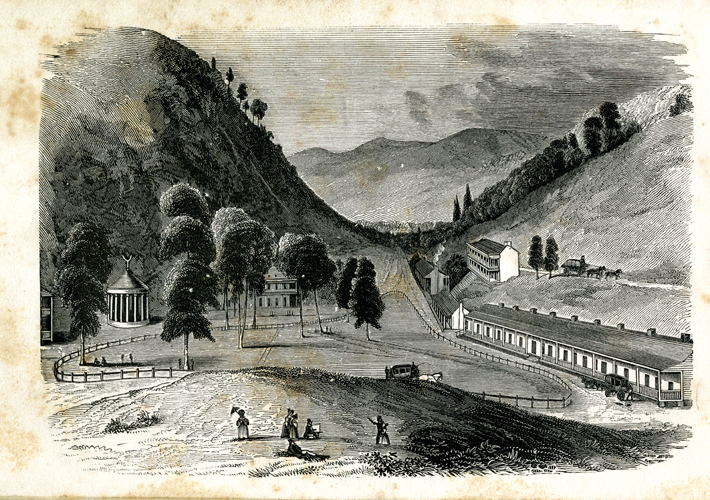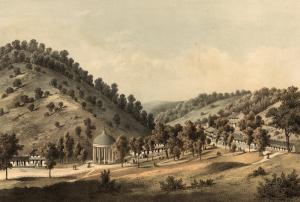Red Sulphur Springs
Monroe County, West Virginia
The composition of this water is essentially different from all the others, and we think it establishes beyond doubt the possession of curative powers previously ascertained by experience. William Burke

This is the frontispiece from a book about a visit in the summer of 1837 to the Red Sulphur Springs by Henry Huntt. {1}
William Burke on the Red Sulphur Springs.
The Red Sulphur Springs are located in Monroe County in what is now West Virginia, and are the furthest west and south of all the springs written about by Dr. Burke in his 1846 book. He described the gorge where the springs are located as being gloomy with only a rude shelter over the springs and several comfortless, windowless cabins when he first visited in 1829. He purchased the springs in 1832 and made many improvements before surrendering possession of the property in 1841. By the time he wrote his book, the Red Sulphur was second only to the White Sulphur in terms of length of the season, overall number of visitors, and the 350 people who could be accommodated at any given time in the hotel and the multiple ranges of beautiful buildings.
Burke said the most noteworthy structure was the Pavilion over the springs. Constructed shortly after his first visit, the pavilion dome was 50 feet above the water level of the springs and was supported by 12 Ionic columns. He devoted more than a third of the 394 pages of The Mineral Springs of Western Virginia to these springs and explained that the uneven treatment of the different springs was a result of the extraordinary, curative powers of the water at Red Sulphur so that, “a more extensive notice than we have given of the other Springs is not only necessary but indispensable to a just estimate of its peculiar action on the human system.” {Burke, 187}
Burke’s Recommendations for Using the Waters at Red Sulphur Springs.
“The idle stories which he will hear that this water has been injured by the writer [Burke], by blowing the rock with gunpowder, is a base fabrication, and that there is no depreciation, as a glance at the analysis will show; but that it is pure and unadulterated as the virgin snow on the summit of the Andes. We, who know, assert this; and we are, surely, as worthy of credit as the miserable retailers of such wicked falsehoods.” { Burke, 323}
Dr. Burke quoted a number of sources to substantiate the medical usefulness of Red Sulphur Springs. He noted that William Rogers, who did an analysis in the mid 1830s, wrote “you may … urge particularly the peculiar value of the water in pulmonary disease.” His inclusion of a more extensive analysis, 20 pages in length, by Augustus A. Hayes from the Roxbury Laboratory near Boston in 1842, also lauded the medical importance of the water.
Dr. Burke incorporated the text of a pamphlet, A Visit to the Red Sulphur Springs of Virginia, during the Summer of 1837, written by Henry Huntt who served as physician to several presidents of the United States. Huntt testified, “It [the Red Sulphur Springs] has been considered peculiarly adapted to the cure of pulmonary diseases, and it is true that it has a most beneficial effect in most cases of this disease; but its good effects equally extend to all cases of subacute inflammation, whether seated in the stomach, liver, spleen, intestines, kidneys, bladder, and most particularly in the mucous membrane.” {Burke, 217}
It is just about as reasonable to expect this [that a one-time cure would protect the affected organ thereafter], as that, being upset in a coach and having a limb fractured, should secure a man from being upset a second time and having his neck broken.” {Burke, 218}
Huntt spent three weeks in the summer of 1837 at Red Sulphur Springs where he sought relief from various symptoms including a cough, chills and fever, and “morbid” sputum. Huntt’s death the following year evidently caused some controversy about the effectiveness of the Spring as Dr. Burke himself wrote, “Will it be objected, as we are informed it has been objected, that he [Huntt] subsequently died of the disease for the cure of which he had so highly eulogized this water? Surely every medical man ought to know that where there is a predisposition to disease of any organ, an actual lesion of that organ, though cured, increases that predisposition, and that it is expecting too much of a medicine, not only to cure the existing disease, but to secure the organ from any future recurrence of that disease.” {Burke, 217-8}
Burke’s major focus was the value of Red Sulphur Springs for consumption, but he did not neglect other diseases including laryngitis, bronchitis, chronic pleurisy, pneumonia, hypertrophy of the heart, kidney and bladder diseases, menstrual disorders, liver diseases, and chronic diarrhea.
Dr. Burke gave specific directions for bleeding of the sublingual vein in acute laryngitis and in “putrid sore throat.” His instructions for the procedure were, “Place the patient in a chair in a reclining posture, seize the tip of his tongue by the medium of a towel, strike the vein with a spring lancet, and the operation is over.” He admitted to having difficulty with this maneuver in infants, but in four year old children he succeeded by the following method: “We apply a powerful mustard plaster to the throat, and when it stings severely, we make a bargain with the child to take it off, provided he will put out his tongue and permit us to perform the operation—he promises, and we remove the plaster, with the understanding that if he breaks his promise we again put it on. We soothe the irritated surface by cooling applications, gain the child’s confidence, and he thrusts out his little tongue without hesitation.” {Burke, 296-98}
A Visit to the Red Sulphur Spring of Virginia by Henry Huntt.
The forest trees of the eastern and western mountains, have been cut down by Mr. Burke, the present worthy proprietor of the Spring, so that this delightful glen enjoys the purifying influence of the sun from seven o’clock in the morning until near five in the afternoon, which makes the grounds much drier than they formerly were, and less liable to morning fogs. Regular stages, or post coaches, arrive here daily, both from the north and south. It is but justice to the amicable and intelligent proprietor, to say, that the improvements he has made, within the short period of four years since he has had the control, give assurance that, should he live a few years longer, the Red Sulphur Spring will not be excelled by any of the numerous places of resort among the salubrious mountains of the Old Dominion, either in magnificence of scenery, beauty, taste, comfort or health. {Huntt, 19}
Physician to Presidents James Monroe, John Q. Adams, and Andrew Jackson, Henry Huntt maintained an active practice among the citizens of Washington D.C. In March 1837 he “was attacked with a slight hemorrhage from the lungs, attended with other symptoms indicating a diseased state of those important organs.” Eventually he lost 20 pounds and experienced an “increased cough, copious, morbid expectoration, hectic chills, fever, and night sweats.” So in the middle of July 1837 he traveled from Washington to Red Sulphur Springs where he found the buildings “spacious and conveniently arranged” and the servants “prompt and obedient.” Dr. Huntt drank the spring water, eventually increasing his consumption to 12 glasses a day. He was unexpectedly called home after three weeks, but wrote that the use of the water led to the “manifest alleviation of the most pressing symptoms of my complaint.” His health continued to be better for months after he departed Red Sulphur Springs, and he credited the water. However, a little more than a year later, on September 21, 1838, he died and was buried in the Congressional Cemetery.
Documents from the Small Special Collections Library, University of Virginia:
The morning was spent much as usual, for here one day telleth for another. I believe I might almost copy any one journal, and it would do for any other day. The same routine of walking to the spring, working a little, talking a little, or rather a great deal, frequently reading a little, and speaking to passing acquaintances, passes off the time. Grace Fenton Hunter
The diary of Grace Fenton Hunter: This journal was written in 1838 by the daughter of Muscoe Garnett Hunter and Grace Fenton Garnett. She was born August 4th, 1817, lived at Elmwood in Essex County, Virginia, and probably died in 1839 or 1840. {3} Hunter describes her six weeks at the Red Sulphur Springs as monotonous days of reading, visiting, going to the spring, walking, riding, and resting. She mentions two deaths that occurred at the Red Sulphur during her visit. She writes of her cough, toothache, and general weakness and debility. Dr. and Mrs. Burke are frequently mentioned. She did not think the time at the spring was profitable for her health and was glad when her stay there was nearing an end.
Letter from Grace Fenton Hunter, 1838: Hunter’s letter is more positive than her diary entry, both written on her 21st birthday and the day after. She writes in her diary that she feels badly and is melancholy with thoughts of hopes overthrown and wasted time. By contrast, the letter discusses the health of Hunter and her companions as seemingly better and more mundane topics such as the weather, food, and people at the springs and at home. Both mention the death of Mrs. Nesbitt.
Additional Information:
- Red Sulphur Springs, Monroe County, Virginia by William Burke: Printed in 1860, Burke’s 24 page book describes how to best travel to the springs, an analysis of the water, diseases that are improved by a visit to the Red Sulphur Springs, and testimonial letters.
- Henry Huntt: This obituary originally from The National Intelligencer, October 1, 1838, gives an account of Huntt’s medical career.
- Monroe County official tourism site: The County site states that nothing remains of the old Red Sulphur Springs except for the stone spring enclosure.
- Library of Congress Prints & Photographs Online Catalog: http://www.loc.gov/pictures/ Search for Red Sulphur, and see two images of Red Sulphur Springs.
Image Credits:
- {1} Henry Huntt, A Visit to the Red Sulphur Spring of Virginia, during the summer of 1837. Boston: Dutton and Wentworth, 1839: frontispiece. Historical Collections & Services, Claude Moore Health Sciences Library, University of Virginia.
- {2} Merritt T. Cooke Memorial Virginia Print Collection, 1857-1907, Accession #9408, Special Collections, University of Virginia Library.
Sources:
- William Burke, The Mineral Springs of Western Virginia, New York: Wiley and Putnam, 1846.
- Henry Huntt, A Visit to the Red Sulphur Spring of Virginia, Boston: Dutton and Wentworth, 1839.
Note that Grace’s full name is variously given by the University of Virginia Library as 1) Grace Fenton Hunter Garnett, 1817-1839, in Papers of the Hunter and Garnett families VIRGO Catalog record); 2) Grace Fenton (Garnett) Hunter, in the online guide for the Papers of the Hunter-Garnett Family; and 3) Grace Fenton Garnett, 1817-1839, in the Fourteenth Annual Report on Historical Collections, University of Virginia Library, for the Year 1943-44, p 24-5. However, the Virginia Historical Society (VHS) gives her name as Grace Fenton Hunter with a death date of 1840. The VHS also says the mother of Grace Fenton Hunter is Grace Fenton Garnett Hunter which helps explain some of the name confusion. Both the VIRGO record and the Annual Report indicate that Hunter’s main visit was to White Sulphur Springs. She did spend several days there, but according to her diary entries, the bulk of her time was at Red Sulphur Springs.
